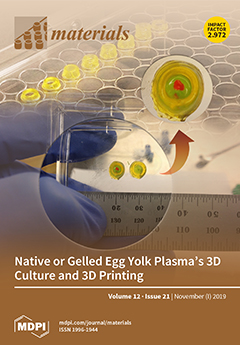This paper is focused on the effect of the stabilizing component SiO
2 on the type and concentration of active sites in SnO
2/SiO
2 nanocomposites compared with nanocrystalline SnO
2. Previously, we found that SnO
2/SiO
2 nanocomposites show
[...] Read more.
This paper is focused on the effect of the stabilizing component SiO
2 on the type and concentration of active sites in SnO
2/SiO
2 nanocomposites compared with nanocrystalline SnO
2. Previously, we found that SnO
2/SiO
2 nanocomposites show better sensor characteristics in CO detection (lower detection limit, higher sensor response, and shorter response time) compared to pure SnO
2 in humid air conditions. Nanocomposites SnO
2/SiO
2 synthesized using the hydrothermal method were characterized by low temperature nitrogen adsorption, XRD, energy dispersive X-ray spectroscopy (EDX), thermo-programmed reduction with hydrogen (TPR-H
2), IR-, and electron-paramagnetic resonance (EPR)-spectroscopy methods. The electrophysical properties of SnO
2 and SnO
2/SiO
2 nanocomposites were studied depending on the oxygen partial pressure in the temperature range of 200–400 °C. The introduction of SiO
2 results in an increase in the concentration of paramagnetic centers Sn
3+ and the amount of surface hydroxyl groups and chemisorbed oxygen and leads to a decrease in the negative charge on chemisorbed oxygen species. The temperature dependences of the conductivity of SnO
2 and SnO
2/SiO
2 nanocomposites are linearized in Mott coordinates, which may indicate the contribution of the hopping mechanism with a variable hopping distance over local states.
Full article






